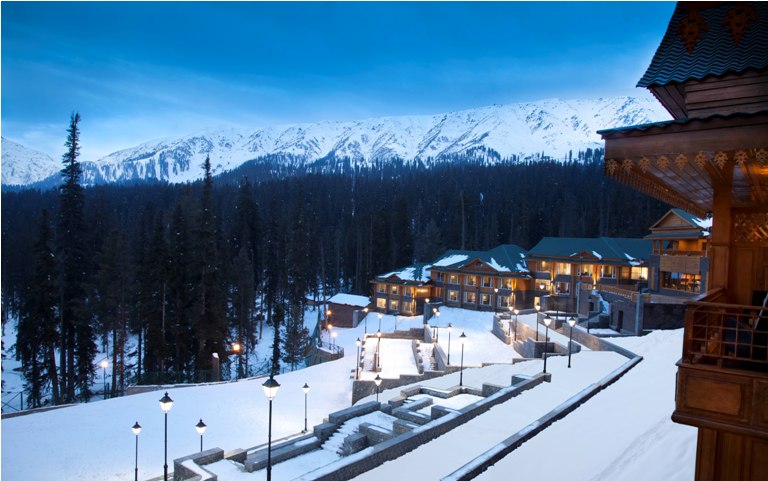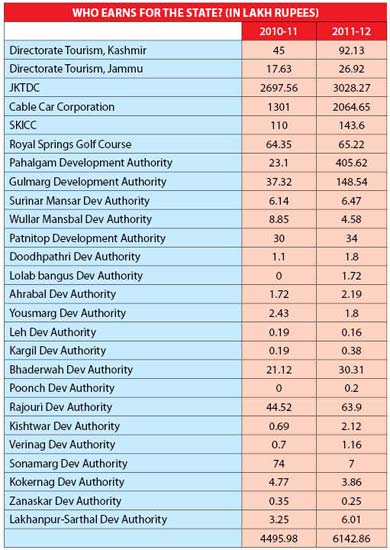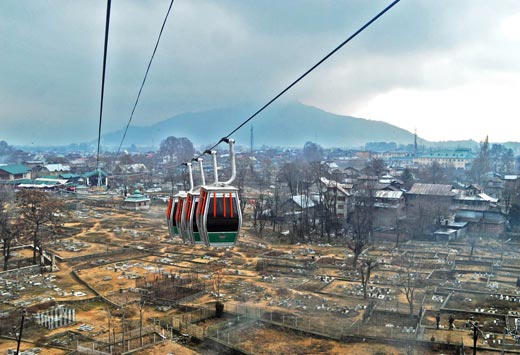As Kashmir appears calm again to the desirous tourists, investors are bullish on the sector while the sun shines and the rush is on. Shams Irfan reports the boom-time activity in the recently declared preferred Tourist Destination-2012 that is getting Bollywood interested again.
With footfall of tourists showing a steady growth in J&K the need for creating world class infrastructure for them in the region has started to gain momentum. Compared to 10.02 million tourists (including pilgrims to Vaishno Devi and Amarnath cave) in 2010, the officials at tourism department say that 12.24 million tourists visited J&K in 2011.
Big names in the hospitality sector like ITC and Taj are already eying investments in the local infrastructure in order to cash in on the tourism boom.
“There is an immediate need for good and sustainable tourism infrastructure in Kashmir,” said Abid Maqbool Bhat, deputy director publicity, department of tourism, Kashmir. “We are expecting even higher numbers in 2012.”
At least two big groups have already started investing in tourism infrastructure in J&K, especially Kashmir, after 2011 remained relatively peacefully following three summers of civil unrest.
Industry sources say that a 90-room five-star hotel by Khyber Group is coming up at Gulmarg. Among other high class facilities, Khyber Mountain Resort is said to include a world-class spa and an indoor swimming pool. Promoter of the project, Umer Maqbool Tamboo said they have already inked a management deal with a US based company, Interstate Hotels that manages more than 400 top-notch hotels across 40 countries. The resort is going to be the first major high-end address in Gulmarg, known famously for its lush green meadow, wild flowers and skiing. “It is by and large ready and we believe it should be ready for formal housewarming around Christmas 2012,” Umer said.
“In last few years Indian tourists have started to reconsider Kashmir among the must visit tourist destinations,” said an industry insider on condition of anonymity. “Last year (2011) being comparatively peaceful has also helped a lot in regaining the confidence of the tourists,” he added. The major improvement is the number of foreigners gradually swelling – from 46000 in 2010 to 68000 in 2011.

In order to meet the growing demand of infrastructure for tourists in Kashmir the department of tourism is encouraging locals to emulate western model of converting their houses into paid guesthouses. “We are trying to encourage people living adjacent to major tourist places like Pahalgam, Gulmarg and Sonmarg to invest in paying guest houses,” said Bhat.
Apart from facilities like subsidized modern kitchen appliances and power generators, the department of tourism is offering up to Rs 2 lakhs of financial support to willing households who wish to use a portion of their house for accommodating tourists. “It will help them in generating extra income and also help in meeting the ever increasing demand of accommodation for tourists,” said Bhat.
“It is a continuous process,” explained a senior Tourism Ministry officer. “In 2009-10 we extended a help of Rs 2.88 crore to 217 beneficiaries across the state,” he said. “In 2010-11 the amount remained the same but the beneficiaries’ increased to 259.”
But there are certain practices that Tourism department cannot help. Every year, for the last 22 years, a large number of hotels and hutments are kept reserved for senior officials and secretariat employees. In 2011, 43 first class huts were booked at Chesm-e-shahi for senior government officials who were part of the biannual Darbar move. According to officials of State Estates Department, the same number of first class huts is booked this year too.
Apart from the luxurious huts overlooking tourist attraction of Dal Lake, the state government books three main Jammu Kashmir Tourism Development Corporation (JKTDC) hotels: Kongposh, Hotel Heemal and Lala Rukh, for secretariat employees every year.
“During Darbar move we have to accommodate around 3000 Jammu based government employees in Srinagar,” said Mohammad Farooq Dar, deputy director Estates Srinagar. Besides having around 800 government dwelling units reserved for these visiting employees, the state government has booked 110 hotels in 2011 and 115 in 2012 respectively for secretariat employees.
The state government hires these hotels and the union ministry of home affairs is providing the funds. Interestingly, the MHA is releasing funds for meals of these employees as well. Though no employee was hurt during the years of unrest, the continuation of this practice is being termed as inducing the vested interest. Most of the hotels being hired could earn much more if they are spared for tourists.
On the other hand, there are many hotels that are still with various security agencies. In 1990 when hundreds of thousands of paramilitary personnel were deployed in Kashmir to fight militancy, there was massive shortage of space to house them. So they occupied places they could find including the hotels. The security men occupied 79 hotels. In the recent years, while 33 of them were restored, there are 46 hotels still housing the security forces.
“If security forces evict all the hotels occupied by them the problem of space for tourist will be tackled to a great extent,” said a department of tourism official on condition of anonymity.
This has triggered a massive pressure on the available space. Almost all major hotels are booked for the season this year and the overall occupancy is hundred percent right now. “Compared to last year the footfall of tourist is good.
Let us hope that things remain peaceful this year too,” said Mushatq Ahmad Wani, who owns a twenty-bed hotel on the banks of Dal Lake. The situation in Pahalgam is that it is very difficulty to get a space even in a dormitory of a hotel. “We are fully booked for next three months,” said hotelier Mohammad Ashraf. “We do not have any cancellations.”
 More footfalls means more money. While the private sector would not offer the exact idea of its turnover, the public sector institutions exhibit an impressive growth in their earnings. Take for instance the J&K Cable Car Corporation (JKCCC) which offers ticketed Gondola (cable car) rides to locations like Affarwat peaks and Kungdoori valley, among major attractions at Gulmarg.
More footfalls means more money. While the private sector would not offer the exact idea of its turnover, the public sector institutions exhibit an impressive growth in their earnings. Take for instance the J&K Cable Car Corporation (JKCCC) which offers ticketed Gondola (cable car) rides to locations like Affarwat peaks and Kungdoori valley, among major attractions at Gulmarg.
“Our earnings jumped to around Rs 24 crore in 2011-12 from Rs 13.5 crore in 2010-11,” said MD JKCCC, Talat Parvez. “We are now focusing on lesser know tourist locations like Yousmarg, Sonmarg, Kokernag and trying to decongest the already popular tourist destinations like Pahalgam and Gulmarg.”
Gandola is the newest attraction in Gulmarg, Kashmir’s all-season destination, barely an hour-long drive north of Srinagar. “Usually winter is considered as an off season in terms of tourist flow but 2011 saw no end to sports lovers from across the world,” said Talat.
This is encouraging JKCCC to invest more in the infrastructure. Last year it completed an open chair lift named Merry Shoulders for skiers for Rs 17 crore which has a capacity to carry around a thousand skiers an hour. “Since last few years there has been around 20 per cent increase in number of skiers visiting Gulmarg during winters,” said Badru Jamali Bhat, General Manger (Technical) JKCCC.
With a peak capacity of carrying 1500 persons per hour from Gulmarg base camp to Kungdoori (first phase), long queues outside the ticket counter is a usual sight. “Around 25 thousand people visit Gulmarg everyday during peak seasons, cable car cannot accommodate them all,” said Jamali.

After the start of Gulmarg Gondola’s second phase in 2005 a large number of tourists started visiting the higher reaches of Affarwat peak every day. With this, the once virgin Affarwat peak, is now chocking under the burden of empty soft drink bottles, biscuit wrappers, and other non-biodegradable items which Indian tourists bring along to their excursion. “We take every possible measure to ensure minimum damage to the fragile ecology of the areas like Kungdoori valley and Affarwat peak,” said Jamali. “We have employed people who are assigned to collect and properly dispose of the garbage generated by the tourists.”
The JKCCC is in a process of completing a 594 meters cable car network that will elevate from Dharamshala Chowk Rainawari to Maqdoom Shaib Shrine (South gate, Kathi Darwaza). The project is to be completed in 18 months at a cost of six crore rupees. “Apart from serving local visitors to the shrine in coming years this [cable car] is going to be one of the major tourist attractions in Srinagar city,” said Noor-ul-Hussain, Assistant Project Engineer.
It is not the JKCCC alone. All the tourism related departments and institutions are making good money. The J&K Tourism Development Corporation that runs an elaborate network of tourist facilities across the state has witnessed a increase in its revenue from Rs 27 crore in 2010-11 to Rs 30.28 crore in 2011-12. Sher-e-Kashmir International Convention Complex (SKICC) on the banks of the Dal that offers world-class conferencing facility had its revenue surge from Rs 1.10 crore to Rs 1.43 crore.
These organizations are investing the money back into the sector. The JKTDC, for instance, is busy implementing four accommodation projects and a convention centre that would cost Rs 19 crore. By now, the officials said, they have already received Rs 6.12 crore and spent Rs 4.66 crore.
The revenue generated by other departments associated with tourism industry in the state by means of entry ticket sales has shown a positive growth too. The directorate of tourism, Kashmir earned 92.13 lakh in 2011-12 compared to 45 lakh in 2010-11. Pahalgam development authority generated a total income of 4.05 crore in 2011-12 compared to just 23 lakh in 2010-11 by means of toll collection and entry ticket sales. Likewise, Gulmarg development authority registered an income of 1.48 crore in 2011-12 compared to just 37.32 lakh the previous year.
“We are outsourcing the ticketing to gardens as we engage ourselves to better upkeep of the assets,” said Sunil Misra, Director Floriculture whose Tulip Garden is currently being visited by 4500 visitors a day. “We have already sold the ticketing rights for Rs 32 lakh, this season and that is the highest bid we ever got,” Misra said. Now even tourism department in Pahalgam has outsourced some of its parks for entry ticketing to private players.
There is, however, visible decline in revenue generated by some of the smaller destinations: Yousmarg collected only Rs 1.80 lakh in entry ticket sale in 2010-11 compared to Rs 2.43 lacks the previous year. Sonmarg collected a meager Rs 7 lakh compared to Rs 74 lakh, Kokernag made only Rs 3.86 lakh compared to Rs 4.77 lakh the previous year.
 This, the officials said, is the outcome of the tourists preferences. Most of the people are keen to visit Gulmarg or Pahalgam and now the government is projecting other destinations. “Our aim is to promote other attractive but less visited tourist destinations by creating Gulmarg like infrastructure at these places,” said Parvez.
This, the officials said, is the outcome of the tourists preferences. Most of the people are keen to visit Gulmarg or Pahalgam and now the government is projecting other destinations. “Our aim is to promote other attractive but less visited tourist destinations by creating Gulmarg like infrastructure at these places,” said Parvez.
In an effort to decongest the already famous locations like Pahalgam, Gulmarg and the surroundings of Dal, the publicity wing of tourism department is placing large hordings across major Indian cities showcasing lesser known places like Tangmarg, Aharbal, Simthan Top, Yousmarg etc.
Now the state government with some financial assistance from central government is undertaking development projects at these locations in order to promote them as viable tourism destinations. In the financial year 2011-12, Yousmarg received Rs 2 crore for its development from state government, Sonmarg got Rs 5.48 crore, from state government and 1.53 crore from central government and Kokernag received Rs 3.19 crore and 5.03 crore, respectively.

But helping tourists to find shelter is not the only thing that tourism industry requires. A section of the trade is marketing fake machine made handicrafts and selling to gullible tourists as hand-made-Kashmir-products. The crisis that is spilling doom for the heritage handicrafts and impacting visitor shopping schedules at the same time needs to be looked at.
“I paid for an original Kashmiri needle-work shawl but later realized that I have been duped. It is a fake Amritsar made replica of the original,” said Harpreet Kaur, a tourist from Chandigarh Punjab, who is staying at a houseboat in Dal Lake with her family.
The enforcement wing of department of tourism has started some efforts. “Our enforcement wing is penalizing those who cheat tourists on a regular basis,” said Mushtaq Ahmad, deputy director, department of tourism Kashmir. “If it is not original Kashmiri product then it should be labeled so. Nobody is allowed to cheat the tourists or sell fakes.”
Such incidents, however, have not deterred Indian tourists from visiting the valley of their dreams. “Last year was good in terms of business. We are already booked till June,” said Abdul Majid Sheikh, who owns four houseboats in the Dal Lake.
















